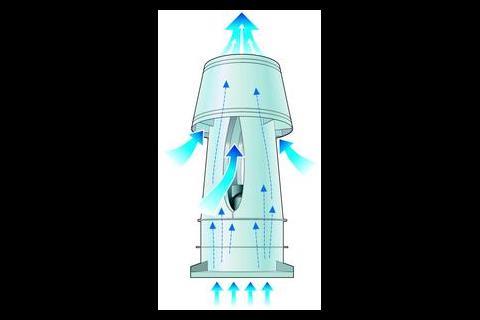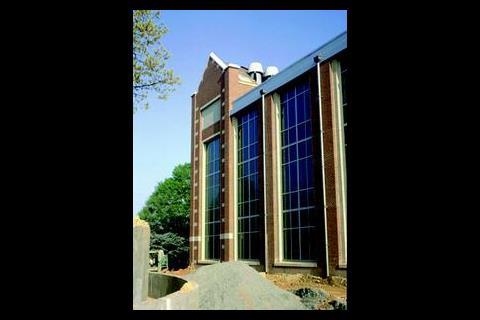For many years one widely used method of handling these exhaust requirements (and others as well, such as exhausting hospital emergency diesel generators), has been with centrifugal, belt-driven rooftop fans with tall, dedicated stacks. For the past few decades, however, mixed flow impeller technology (employed in low profile roof exhaust fans) has gained popularity. While there are many drivers for the increasing interest in this technology, the main reason is the performance/cost advantages it offers for handling problematic roof exhaust applications.
Exhaust re-entrainment can be a serious problem, and all of its negative implications may not be widely known. Laboratory workstation exhaust discharges, for example, can be toxic, noxious or odoriferous. Their danger to people covers a broad spectrum from mildly annoying (but not harmful) to seriously unhealthy under certain conditions.
However, in the unlikely event that exhaust re-entrainment is not a health concern at a facility, generating odoriferous emissions can also create problems in the neighbourhood. A facility producing them – regardless of toxicity – will ultimately be confronted, either by its neighbours or a regulatory body.
The stacks also usually require expensive mounting hardware such as bases, guy wire supports and roof curbs, and often they still do not prevent re-entrainment of exhaust fumes back into the building or adjacent facilities. In addition, the belt driven centrifugal fans associated with these systems require periodic belt inspection and other maintenance, and often are housed on the roof in separate plant rooms. However, maintenance people working on these fans can also be subjected to exposure from toxic and/or noxious fumes, and the fans must be shut down during these procedures thus contributing to process or production downtime.
Mixed flow impeller systems operate by diluting contaminated exhaust air with unconditioned, outside ambient air via an integral bypass mixing plenum. The diluted exhaust air is accelerated through an optimised discharge nozzle, or windband where nearly twice as much additional fresh air is introduced through natural aspiration effect into the exhaust plume before leaving the fan assembly. The combination of added mass and high discharge velocity maximises discharge exhaust momentum. This, in turn, virtually eliminates the risk of contaminated exhaust being re-entrained into the building. As an example, a mixed flow fan moving 2265 m3/min of combined building and bypass air at an exit velocity of 1920 m/min can send an exhaust air jet plume up to 37 m high in a 16 km crosswind. This extremely high velocity exceeds ANSI Z9.5 standards by more than twice the minimum recommendation of 914 m/min). Because up to 170% of free outside air is induced into the exhaust air stream, a substantially greater airflow is possible for a given amount of exhaust – providing excellent dilution capabilities and greater effective stack heights over conventional centrifugal fans without additional horsepower.
CFD analysis
Roof exhaust re-entrainment can also be affected by building locations with regard to adjacent buildings as well as prevailing wind and weather conditions. As a result, when renovating or for new construction computational fluid dynamic analysis (cfd) has also become important – especially with regard to indoor air quality – since harmful exhaust gases must not be allowed to re-enter a building or adjacent buildings and must exhibit adequate plume dispersal to limit the effect on the local environment.
CFD analysis should also be considered under certain circumstances. These studies are typically performed using proprietary Phoenix fluid flow programmes which predict exhaust concentrations both at the boundary of the plume and within it. This includes ground level as well as rooftop and free field locations. While all facilities don't necessarily require cfd analysis it should be performed where any questions exists with regard to exhaust stack design, adjacent buildings, and re-entrainment possibilities that will affect both indoor air quality and the surrounding environment.
CFD analysis can also aid other design issues such as manifolding of exhaust fumes versus non-manifolding. Manifolding exhaust is often beneficial because the plume rise of an exhaust is proportional to the diameter of the exhaust and exit (efflux) velocity. Manifolding sources of exhaust together creates high exit velocity and a high diameter simultaneously whereas without manifolding the exhaust exit velocity may be high but exhaust diameter would be smaller. Combining exhaust sources together provides a higher plume rise, which is important for lowering concentration of exhaust.
Mixed flow impellers
Mixed flow impeller technology is a combination of axial, radial, and centrifugal flow principles. Mixed flow impeller technology capitalises on the performance characteristics offered by each of these fan types by combining them into a fan blade where both sides perform equal work regardless of volume. As a result, the blades' (or fan wheels') performance curve is perfectly stable with no stall or unstall sections. These characteristics provide substantially lower vibration over comparable centrifugal-type fans, thus permitting mixed flow impeller fans to incorporate direct drive motor configurations. The adage of fewer moving parts result in fewer breakdowns is true. A direct drive system has one potential point of failure – the motor. Conversely, a typical belt drive system has five potential points of failure, including belts and pulleys, and motor, shaft, and possibly pillow block bearings.
Another consideration when retrofitting or designing new roof exhaust systems includes the aesthetics of stack height. Ideally you would seek the lowest profile possible which not only eliminates the smoke stack look on the rooftop, but may also help conform to applicable architectural/aesthetic and planners' concerns. Elimination of tall, unsightly stacks which are either prohibited by planning or undesirable is an added benefit. In addition, low profile mixed flow impeller fans don't require structural reinforcements on the roof, or complex, expensive mounting/stabilising hardware such as elbows, flex connectors, or spring vibration isolators.
Time and costs
Exhaust system designers are always looking for modular, easy to apply solutions that result in quick project turn around for new installations, and minimal downtime in retrofit applications. Minimal downtime ultimately means lower costs for labour and services. Because they are constructed modularly, low profile, mixed flow impeller fans also offer substantially reduced installation time and costs over centrifugal-type fan systems. Direct drive mixed flow fan systems offer wide design flexibility because they can be located to the side or on top of mixing plenums. This reduces required roof space compared to belt drive centrifugal systems that are commonly mounted next to a plenum on a common spring base.
Mixed flow impeller systems are also quieter, use less energy, and provide enhanced performance with faster payback over traditional centrifugal fans for laboratory fume hood exhaust systems. A typical reduction of £0.18 per m3/minute at £0.04/kWh provides an approximate two year return period on investment. Energy consumption for mixed flow fans is about 25% lower than centrifugal fans with substantially reduced noise levels, particularly in the lower octave bands. They also conform to all applicable laboratory ventilation standards of ANSI/AIHA Z9.5 as well as ASHRAE 110 and NFPA 45, and are listed with the Underwriters Laboratory under UL 705 (certified electrically safe).
In addition to these performance, cost and aesthetic considerations, there are many others of concern for facility managers, designers, contractors, and owners. Among them are exhaust acoustics (considered part of a building's aesthetics), and the various options available for reducing perceived fan noise at the property line; and, wind studies that help determine fan power requirements, location on a building's roof and possible sources of re-entrainment. Of major concern today is the cost of a building's overall hvac system. Energy costs have been rising continually for the past few years, and there doesn't appear to be any reasonable end in sight. To that end, many closed-loop, 100% make up air laboratories (ACDP CL 2 or 3 level laboratories, for example) could also take advantage of the unprecedented heat recovery capabilities offered by mixed flow impeller technology.
Heat recovery savings
Mixed-flow impeller systems can also provide significant energy savings for facilities that require 100% makeup air. When used with heat recovery modules, these systems recycle warm (or cool) air before discharging it into the atmosphere and transferring the sensible heat back into the building's intake ventilation system. Arrangements like this are highly efficient. For example, with each 1°C added to the makeup air, energy costs are reduced by approximately 3%. It isn't unusual to see heating energy cost reductions of 30% or more. Similar savings, although not as dramatic, can be achieved for cooling. With today's high energy costs mixed-flow impeller systems with heat recovery modules can provide building owners with a payback as short as two years. In general, these systems are usable when outside air temperatures are below 10°C or above 24°C.
Source
Building Sustainable Design
Postscript
John Gibson ACIBSE, ISPE is associate director, and laboratory and pharmaceutical team leader at engineer consultancy Scott Wilson. For the past 15 years, Gibson has specialised in designing for the laboratory sector.
























No comments yet